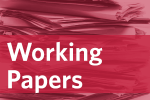
As startups are at the forefront of adopting AI tools, it is important to understand whether AI can amplify the effects of lean methods in helping startups to be even more responsive to market conditions that before. And if so, to what extent and under what conditions AI can complement lean method in developing products.…Read More




